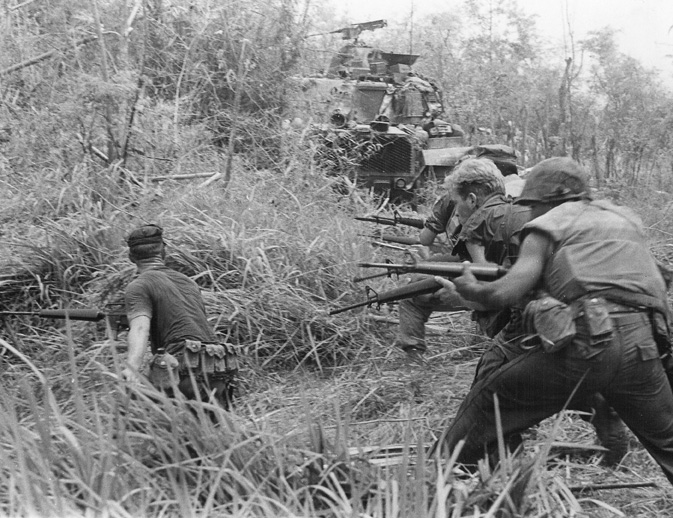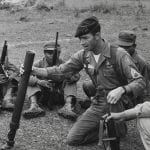The following Vietnam War summary is an excerpt from Lee Edwards and Elizabeth Edwards Spalding’s book A Brief History of the Cold War It is available to order now at Amazon and Barnes & Noble.
Halfway around the world, another Cold War conflict was escalating. The struggle for control of Vietnam, which had been a French colony since 1887, lasted for three decades. The first part of the war was between the French and the Vietminh, the Vietnamese nationalists led by the communist Ho Chi Minh, and continued from 1946 until 1954. The second part was between the United States and South Vietnam on one hand and North Vietnam and the National Liberation Front on the other, ending with the victory of the latter in 1975. The communist side, strongly backed by the Soviet Union and mainland China, sought to increase the number of those who lived behind the Bamboo Curtain.
Both the United States and the Soviet Union regarded the conflict not as a civil war between North and South Vietnam but as a consequential engagement of the Cold War in a strategic region. American leaders endorsed the domino theory, first enunciated by President Eisenhower, that if South Vietnam fell to the communists, other nations in the region such as Laos and Cambodia would also fall.
Vietnam War Summary—A Cold War Quagmire
Five American presidents sought to prevent a communist Vietnam and possibly a communist Southeast Asia. Truman and Eisenhower provided mostly funds and equipment. When Kennedy became president there were fewer than one thousand U.S. advisers in Vietnam. By the time of his death in November 1963, there were sixteen thousand American troops in Vietnam. The Americanization of the war had begun.
Kennedy chose not to listen to the French president, Charles de Gaulle, who in May 1961 urged him to disengage from Vietnam, warning, “I predict you will sink step by step into a bottomless military and political quagmire.”
A debate continues as to what Kennedy would have done in Vietnam if he had served two terms—widen America’s role or begin a slow but steady withdrawal. We do know that throughout his presidency, Kennedy talked passionately about the need to defend “frontiers of freedom” everywhere. In September 1963, he said “what happens in Europe or Latin America or Africa directly affects the security of the people who live in this city.” Speaking in Fort Worth, Texas, on the morning of November 22, the day he was assassinated, Kennedy said bluntly that “without the United States, South Viet-Nam would collapse overnight. . . . We are still the keystone in the arch of freedom.”
Kennedy’s successor, Lyndon B. Johnson, was an ambitious, experienced politician who had served in both the House and the Senate as a Democrat from Texas, and his persona was as large as his home state. He idolized FDR for winning World War II and initiating the New Deal and sought to emulate him as president. Like the three presidents who had preceded him, he saw action in time of war, serving as a naval aide in the Pacific during World War II, and like them he was a Christian, joining the Disciples of Christ Church in part for its focus on good works. Drawing on his political experience, Johnson thought that Ho Chi Minh was just another politician with whom he could bargain—offering a carrot or wielding a stick—just as he had done as the Senate majority leader. Ho Chi Minh, however, was not a backroom pol from Chicago or Austin but a communist revolutionary prepared to fight a protracted conflict and to accept enormous losses until he achieved victory.
Campaigning in 1964, Johnson promised, “We’re not about to send American boys nine or ten thousand miles from home to do what Asian boys ought to be doing for themselves.” It was a promise he failed to honor. In August of that year, after North Vietnamese patrol boats reportedly attacked two U.S. destroyers, the president got the congressional authority he needed to increase the American presence in Vietnam—the Gulf of Tonkin Resolution, passed by an overwhelming margin in the Senate.
Once elected, Johnson steadily increased the troop levels until by early 1968 there were more than half a million American servicemen in Vietnam—a course of action Eisenhower had strongly opposed. Johnson quadrupled the number of bombing raids against North Vietnam but barred any invasion of the North by U.S. or South Vietnamese forces, fearful of triggering a military response from Communist China. Johnson’s fears were misplaced: China was caught up in the bloody chaos of the Cultural Revolution. For a decade, the People’s Liberation Army was busy trying to advance the Cultural Revolution while controlling the Red Guards, the fanatical youth movement that the Cultural Revolution had unleashed.
Why was LBJ so determined to defend South Vietnam? Ever conscious of his place in history, the president compared the risk of Vietnam going communist to the “loss” of China in 1949: “I am not going to lose Vietnam,” he vowed. “I am not going to be the president who saw Southeast Asia go the way China went.” In a nationally televised speech in 1965, he said, “The central lesson of our time is that the appetite of aggression is never satisfied. To withdraw from one battlefield means only to prepare for the next.”
But what if the enemy shows no sign of giving in? By 1968, after three and a half years of carefully calibrated escalation, the Pentagon concluded that the North Vietnamese could continue to send at least two hundred thousand men a year into South Vietnam indefinitely. As one analyst wrote, “The notion that we can ‘win’ this war by driving the VC-NVA [Viet-Cong and North Vietnamese Army] from the country or by inflicting an unacceptable rate of casualties on them is false.”
The Tet offensive of January 1968 seemed to confirm such an analysis. Some eighty-five thousand Viet Cong attacked Saigon and other major cities in the south. In most cases, the military historian Norman Friedman writes, the attackers achieved complete tactical surprise. There were dramatic successes, such as penetration of the U.S. embassy in Saigon and the capture of the old imperial capital Hue. Nevertheless, both the U.S. army and the South Vietnamese army fought well. The civilian population in the South did not rise up against the Saigon government but rejected the communist invaders. It was estimated that 40 percent of the communist cadres were killed or immobilized. The Viet Cong never recovered.
But the American news media reported the Tet offensive as a U.S. defeat, even a debacle. A frustrated and discouraged President Johnson did not know what to believe—the positive reports of his generals or the negative reporting of the media. The public opted for the latter.
Domestic opposition to the war was fueled by the mounting casualties (more than fifty-eight thousand Americans died in Vietnam). CBS News anchorman Walter Cronkite—the “most trusted man in America,” according to a Gallup poll at the time—counseled America’s withdrawal in a widely viewed telecast. The president is said to have told an aide that if they had “lost” Cronkite, they had lost the average citizen. Tens and then hundreds of thousands of anti-war protestors filled the streets of Washington, D.C., chanting, “Hey, hey, LBJ, how many kids did you kill today?”
The inability of the United States to achieve a “final” military victory over the North Vietnamese seemed to confirm Mao’s axiom that peasant armies could triumph over modern armies if they were patient and had the necessary will—qualities North Vietnam had in abundance.
Furthermore, the war in Vietnam was affecting U.S. strategic planning across the board. By 1968, experts argued, it would be difficult for the United States to respond anywhere else in the world because of its commitments in Vietnam.
This post is part of our larger educational resource on the Vietnam war. For a complete history and overview of the Vietnam War, click here.
 |
This Vietnam War summary is an excerpt from Lee Edwards and Elizabeth Edwards Spalding’s book A Brief History of the Cold War. It is available to order now at Amazon and Barnes & Noble.
You can also buy the book by clicking on the buttons to the left.
Additional Resources About Vietnam War
Cite This Article
"Vietnam War Summary—Overview of the Conflict" History on the Net© 2000-2024, Salem Media.
April 25, 2024 <https://www.historyonthenet.com/vietnam-war-summary>
More Citation Information.








